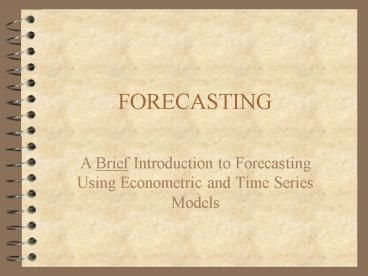FORECASTING - PowerPoint PPT Presentation
1 / 14
Title:
FORECASTING
Description:
Decomposes time series into a time trend, a seasonal factor, a cyclical element ... Nonstationary series exhibits some sort of upward or downward trend over time. ... – PowerPoint PPT presentation
Number of Views:35
Avg rating:3.0/5.0
Title: FORECASTING
1
FORECASTING
- A Brief Introduction to Forecasting Using
Econometric and Time Series Models
2
Two Broad Approaches
- Econometric forecasting
- Based on a causal, regression model
- Conditional vs Unconditional Forecasting
- Use of Leading Indicators
- Times Series forecasting
- Decomposes time series into a time trend, a
seasonal factor, a cyclical element and an error
term - History provides guide to the future
3
Econometric Models
- Four Potential Sources of Error
- Specification error
- Conditioning error
- Sampling error
- Random error
- Forecasting Confidence Intervals
4
Confidence Interval
5
Miscellany
- If model has serially correlated errors that you
corrected with GLS, do not use GLS model to
forecast. - With simultaneous systems (no lagged endogenous
variables), use reduced form model to forecast. - If dependent variable in log form, must adjust
forecast to eliminate bias.
6
Trend Line Fitting
7
Trend Line Fitting
- Assumes that past behavior will continue
- Used to generate short run forecasts
- Used to detrend data so as to explain
fluctuations around the trend
8
Time Series Models
- Autoregressive model
- Yt is a function of Yt-1, Yt-2, and a white
noise error term - Moving average model
- Yt is a linear combination of past values of the
error series - ARMA models
- Mixture of autoregressive and moving average
models
9
ARMA or ARIMA Model
AR(p,q)
10
Stationarity
- Stationary time series is one where dependent
variable has a constant mean and variance over
time. Nonstationary series exhibits some sort of
upward or downward trend over time. - ARIMA model can only be applied to stationary
series. To convert nonstationary to stationary,
take first differences
11
Steps in Time Series Modeling
- Identification -- specification of p,d and q
- Estimation
- Diagnostic checking
- Forecasting
12
Identification
- Examine plots of data , the ACF, the correlogram
to choose d - Choose p and q through iterative process designed
to eliminate autoregressive and moving average
components. The residuals should be white noise.
Examine the ACF and the PACF
13
Behavior of ACF and PCF
14
Diagnostic Checking
- Box-Pierce statistic
- Ljung-Box test statistic

